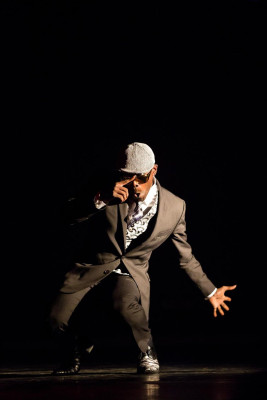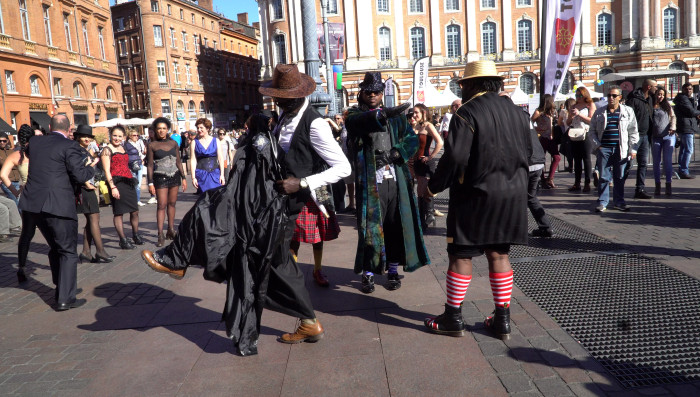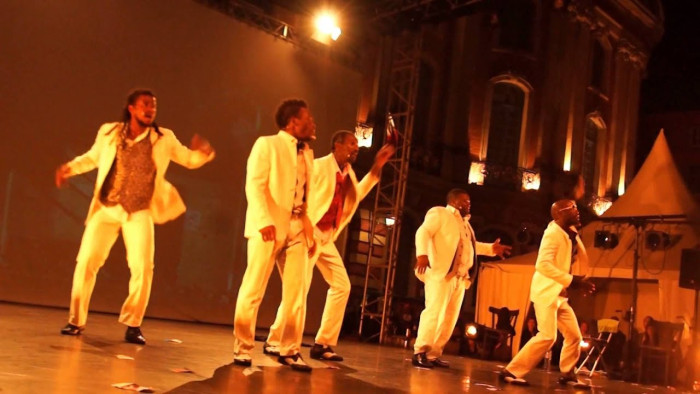Roots of Diversity in Contemporary Dance
- Contemprary European dances
- Cotemporary danses from the United States
- Contemprary African dances
- Contemporary Caribbean dances
- Contemprary Israeli dances
- Butō : a Japanese contemprary dance
- Urban Dances
- Jazz dances
Contemprary European dances
Contemporary dance developed itself in Europe in the 1970s, under several influences, including the "New French Dance". This current wanted to detach itself from modern American dance, and the influence of the Paris Opera on the French artistic scene. In Germany, we have to mention Pina Bausch and her work on dance-theater, or Mary Wigman, pioneer in expressionist dance. Contemporary dance in Europe remains a rich scene with a multitude of artists from various horizons.
Vêpres #2
Vespers danced and interpreted by James Carlès, accompanied by Emmanuel Pi Djob at the creation of the project at the Altigone cultural center in Saint-Orens (suburb of Toulouse). Breathing, a fundamental concept in contemporary dance, is the starting point for the creation of this solo.
Furthermore, James Carlès created, like Ohad Naharin, a method with adapted solutions for injured or physically limited dancers (the R.E.S.E.T©).
The JC Danse©, from the R.E.S.E.T©, created by James Carlès, allows you to listen to your body and your breathing, in order to better understand the benefits of fluidity, musicality, gesture, expression, creativity...
The JC Dance© is one of the rare trans-cultural techniques created in Europe.
CIe Pedro Pauwels - DCN 2013
Pedro Pauwels is a Belgian contemporary dancer. Here, he reinterprets a piece by Mary Wigman from 1914: "La Danse de la Sorcière" for the Festival Danses et Continents noirs 2013. This dance was at the time intended to break with the classical, showing sudden movements made by curved and tormented bodies.
Concerto 5.31
2008 - Director : Hérédia, Clément
Choreographer(s) : Carlson, Carolyn (France) Carlès, James (France)
Carolyn Carlson was born in 1943 in the United States but became in the 1970s a figure of the New French Dance. She creates in 2014 her own company in France. She wrote this solo for James Carlès and follows the elements of Alwin Nikolais' concept: "motion", to which she adds her poetic and spiritual dimension.
"Dance is greater than the dancer and always will be, despite the paradox that it can only exist and function through its living instrument".
Mary Wigman
Cotemporary danses from the United States
Contemporary American dances grew up around strong and immutable figures, having contributed durably to constitute artistic bases, on which others will lean in order to create their own universe, to bring their energy to the public. Dancers such as Merce Cunningham, Lester Horton, José Limon, Katherine Dunham or Pearl Primus, for instance, have left such an imprint that their techniques and their contributions are still studied today, in courses, masterclasses, or in structures such as The Cunnigham Dance Foundation, or Los Angeles Dance Project. The works of these artists are still played, reinterpreted by the new generations.
American inspirations are multiple.
Event Merce Cunnigham au CDNC d'Angers
2016 - Director : Carlès, James
Choreographer(s) : Cunningham, Merce (United States) Swinston, Robert (United States)
James Carlès and Robert Swinston, two choreographers with different inspirations and practices, join together around a common event at the CDNC in Angers, paying tribute to Merce Cunningham. Robert Swinston, now Artistic Director of the CDN has worked with Merce Cunningham, Martha Graham, the Mexican dancer José Arcadio Limon and the Paris Opera Ballet.
Marcus Jarrel Willis au stage d'automne 2020 du CCJC
2020 - Director : Carlès, James
This is a lesson given by Marcus Jarrell Willis, a former member of the Alvin Ailey Company, during an international workshop at the Centre Chorégraphique James Carlès. M.J. Willis trained with the Alvin Ailey Dance Theatre. He is now exploring choreographic practices and passes on his knowledge in masterclasses around the world.
Mourner's bench
Georgey Souchette interprets in solo " Mourner's Bench " by Tally Beatty, transmitted by James Carlès and the American company Philadanco and still considered today as one of the best American choreographers. He studied with Martha Graham and Katherine Dunham. Mourner's Bench" tells the dramatic story of the Ku Klux Klan's influence on a multi-ethnic rural community in the southern United States.
« Why do I dance? Dance is my medicine. It’s the scream which eases for a while the terrible frustration common to all human beings who because of race, creed, or color, are ‘invisible’. Dance is the fist with which I fight the sickening ignorance of prejudice. »
Pearl Primus
Contemprary African dances
Nowadays, contemporary African dances occupy a prominent place in theaters and dance festivals in Europe but also all over the world. We can see inspirations, approaches, common themes, without however arranging the artists mentioned above under the same optics. Practices remain diverse, but the memory of the end of the slave trade, decolonization, movements between two continents, the relationship to music, traditions, theater act as many reasons to unite methods and artistic visions. The artists mentioned above, have contributed to what the journalist Isabelle Danto calls a "choreographic revolution" comming from Africa.
Cours de Léna Blou au centre chorégraphique James Carlès
Germaine Acogny is a French-Senegalese dancer, practicing contemporary African dances. She practiced her art first in Senegal, then in Belgium and France for instance. Close to Maurice Béjart, she created in 2004 an international center for contemporary and traditional dances in Toubab Dialo: L'École des Sables.
The birth of "coupé décalé"
Coupé-décalé is a dance and a music style born in Ivory Coast in the early 2000s, with a strong emphasis on rhythm and percussion, with African sounds. It developed in Paris, mostly in nightclubs. One can notably quote Douk Saga, DJ Arafat, or Serge Beynaud as known heads of the coupé-décalé.
Interview de Germaine Acogny pour le Centre chorégraphique James Carlès
" Dancing to fight"
Zora Snake
Contemporary Caribbean dances
Choreographic creation in the Caribbean has its own codes, its own diversity, which has recently connected with artistic movements from Europe and the United States. In Guadeloupe, the Centre de la Danse et des études chorégraphiques created by Léna Blou after her studies in metropolitan France tends to become a major pole of the Caribbean choreographic art. We can also talk about the contemporary dance company from Martinique managed by Christiane Emmanuel. The Centre chorégraphique and the Compagnie James Carlès Danse&co have had the opportunity to work with Léna Blou during international workshops and dance festivals.
Cours de Léna Blou pour le Centre chorégraphique James Carlès
Léna Blou is a dancer, choreographer, historian, and creator of Gwoka dance. After years of research, she has created a Caribbean contemporary dance: Techni'Ka, offering the dancer a physical and musical exploration. An approach of the "Body's states" with multiple possibilities...
Interview de Léna Blou pour le centre chorégraphique James Carlès
2018 - Director : Carlès, James
"The singularity of the festival is to cross the writings, and especially to cross research, thought, that the body is thought [as] a tool for understanding the world..."
Léna Blou about the Festival Danses et Continents noirs
"What is "Guadeloupean contemporary" dance? Is it a dance that has been influenced by French contemporary dance, therefore that could be limiting, or is it a Guadeloupean dance of today, therefore Caribbean, therefore multicultural, therefore full of an enrichment that allows openness to expression, communication and exchange? »
Fred Lasserre, interview with Stéphanie Bérard for Africulture.
Contemprary Israeli dances
Contemporary Israeli dances are on the crossroad of contemporary, modern dance and gaga style. At the moment, the Israeli dance scene is shining internationally, first thanks to Ohad Naharin, and now with the performances of Hofesh Shechter, who trained with the Batsheva company. One can for example mention the choreographic representation "Show", mixing contemporary dance, urban trance and electro, performed by eight young dancers under the direction of Hofesh Shechter. Themes addressed in Israeli pieces often deal either with tragic historical facts or with themes of daily life.
Echad Mi Yodea
Echad mi Yodea is a traditional Jewish choreographic and sung piece. The tone and form are meant to be funny and humorous, as important lessons to give to children. Ohad Naharin has reappropriated the piece, in order to produce and perform it on stage. Here, the Junior Ballet Toulouse-Occitanie, directed by James Carlès, reinterprets the play.
Political Mother : extract
Political Mother is a contemporary piece created and choreographed by Hofesh Shechter. It is an artistic work that aims to question on political indoctrination and totalitarism. The electric, rock, and musical dimension of the piece expresses the power of Shechter's dance. The Professional Trainig of the Centre Chorégraphique James Carlès worked on this piece during the year 2016-2017.
"The Batsheva Dance Company's move after long years of absence in Paris created the effect of a choreographic explosion. »
Philippe Noisette, French journalist and critic, on the play Naharin's Virus in 2014.
Butō : a Japanese contemprary dance
Tatsumi Hijikata and Kazuo ōno are considered as the main founders of this choreographic practice. Butō is steeped in Buddhism and Shintoism, but also inspired by European artistic currents such as German Expressionism or Surrealism. The Butō has been carried by artists such as Akaji Maro, director of the Dairakudakan troupe, or Yoko Ashikawa, dancer in Tatsumi Hijikata's troupe.
"Personally, the search for butô dance develops and deepens in an exploration of oneself, of one's existence, of human life, in relation to others, daily life, society, nature and the universe...with in parallel, a constant study of one's own body which is unique. The body, material of dance, is there like a stone placed on the earth by chance".
Maki Watanabe, Butô dancer and choreographer
Urban Dances
Dance evolved in 1970, under the impulse of New York, with the emergence of urban dances of which hip-hop is one of the main incarnations. They will emphasize the importance of singularity and community, and take on a political message, especially concerning racism and social violences. Its influence is huge in contemporary dance, with the renewal on the performance. Afro beat, as an example emphasizes addressing the audience, exploring gesture, stepping and movement.
The number of contemporary dancers practicing urban dances confirms the reality of hybridization among young dancers. It is a driving force in the development of contemporary creation.
Conférence danseée Olivier le François ( Théma)
2016 - Director : Carlès, James
In this danced conference, Olivier Lefrançois mixes factual, historical, and practical explanations. We see him apply the facts he relates. Here, the stage practice also shows diversity as such, mixing lecture, choreography, storytelling, and humor. In this performance, the artist expresses his love of contemporary dance and hip-hop.
Danses Noires
This interview with James Carlès, planned for the video format, talks about the development and sharing of black dances. The introduction, along with other passages, is a demonstration of this panel of dances that belong to different social and political histories.
Cours de Brissy Akézizi au stage d'automne 2019 au CCJC
2019 - Director : Carlès, James
Brissy Akezizi is a dancer, performer, also choreographer and creator of Dancehall coupé-décalé. Influenced by traditional African and Afro-urban dances (hip-hop, dancehall, Azonto, contemporary dances...). Regular teacher at the Centre Chorégraphique James Carlès, he gives here a course during an international workshop.



Défilé-sapé in Toulouse's streets
It is an open show in the center of Toulouse, proposing a direct interaction between the city and artistic practice. This scenic form as well as the performance itself have a resolutely contemporary aspect, freeing itself from the limits usually imposed by their accessible and innovative aspect. The performance was preceded by a "défilé sapé" in the streets of Toulouse.
These new scenic practices abound, but the vast majority come from Afro-descendant communities all over the world. The particularity today is that the dominant current is no longer American, but African and Caribbean, or also European. Indeed, many Afro-descendant urban dances, since the 2000s, come from European capitals (Paris, London, Lisbon, Barcelona, Madrid, Berlin...) Their strength is the appropriation of public space and the creation of their own codes, conveyed in a viral way by the youth, through social networks.
Jazz dances
The influence of Jazz can be found in modern music, cinema, plastic arts or literature. Many artists of the young French dance, came, without saying it, from a training in Jazz. This is still the case.
Jazz dances are divided into three main groups. Social or vernacular dances, entertainment dances and "concert" dances. The places of junction of the jazz dances of concert and several currents of the modern-contemporary dance are numerous, because they share the same base of aesthetic reference, and socio-political, with a phenomenon of strong and assumed hybridization among the actors of the jazz dances.
Some names of authors of the Jazz "Jazz de concert" dance: Jack Cole, Matt Mattox, Luigi, Réné Deshauteurs, Rick Odums, Géraldine Armstong.
Oh Lord [integral]
2012 - Director : Carlès, James
Choreographer(s) : Carlès, James (France) Armstrong, Géraldine (Grenada)
The Company James Carlès Danse & Co, like the company Alvin Ailey is a repertory company. Concerned with a wider recognition of the choreographic heritage of the 20th century. It reconstructs with the authors or rights holders of reference works for the history of dance. Oh Lord is a creation of the choreographer Géraldine Armstrong. This choreographer is influenced both by the technique of her master Mat Mattox and the choreographer Alvin Ailey, who inscribes her approach in the cultural and spiritual experience of Afro-descendants.
Conclusion
Through this thematic journey, we have proposed a photograph of the circulation of dances in the world, to show the importance and the forms that diversity can take and that diversity allows within the framework of contemporary dances. The achievements of the artists of the Centre chorégraphique and the Compagnie James Carlès have placed this notion of diversity at the heart of their practices and their artistic philosophy.
It seems crucial to diversify media and aesthetics in order to make the senses and symbols interact. Mixing and diversity seem to be at the origins of contemporary dance, while being a powerful vector of creative energy.
By all means, let's dance together!